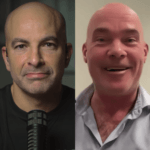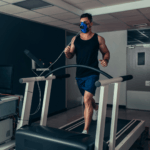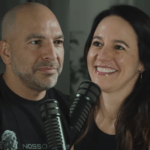In the summer of 2009 I was preparing for a swim that nobody had ever done before.
Marathon swimmers are always looking for a body of water that has never been swum by someone else. The span of ocean between Catalina Island and Santa Barbara Island (SBI) seemed like a perfect spot. Four years earlier I had swum from Catalina Island to Los Angeles and three years earlier I had been part of a relay team that swam from SBI to LA.
This stretch of water between Catalina and SBI would be a tough swim for reasons too numerous and mundane for this post. The swim was scheduled for a window in early September, but by early July, my right shoulder was really hurting during any training swim that exceeded six hours. By late July, the pain was getting very sharp by hour four of each training swim. After an arthrogram (an MRI where they inject contrast directly into the shoulder joint) and a visit with an orthopedic surgeon, we had what appeared to be a diagnosis. I had a torn labrum. The surgeon recommended surgery, which would require being in a sling for six weeks post-op and a period of no swimming for nine months.
I asked the surgeon if continuing to swim for a few more months, despite the pain, would reduce the chances of a successful surgery. He said no, and so I decided to suck it up and keep training. I did, however, decide to opt out of what I considered would be a very tough Catalina to SBI swim—something I estimated would take at least 12 hours in very rough water—in favor of what I assumed would be a much more manageable LA to Catalina swim. Generally the currents make this swim slightly easier than swimming from Catalina back to the mainland, which I had already done in 2005, only 18 months after really learning how to swim. It took 10 and a half hours, so I assumed this would be a pretty straightforward swim. (Any ocean swimmers reading this are laughing at this point. Such hubris always gets you spanked.)
The story of this swim is one of the most painful of my athletic career. A last-minute change of the current—head on—turned this into 14 hour-plus swim, in some of the roughest chop (first and only time I was ever sick in the water) of which the last eight hours I was screaming under the water from the pain so my crew would not hear me. Unlike my first Catalina swim where I was able to enjoy the marine life and sights and sounds of the ocean, this was my equivalent of Ali’s third fight against Joe Frazier (“the closest thing I’ve ever known to death,” he would say following his victory). Ali had it worse, to be sure, but this was unsettling pain.
Parenthetically, if anyone is wondering how dark it is when you’re swimming in the ocean at 2 am, it’s really dark, hence the glow-stick on my back so they can see me when not shining giant light down from the boat (which I hate, as it makes it impossible to see the bioluminescence–the swimmer’s reward for swimming in complete darkness).
A week following the swim I had another arthrogram which showed the tear was, more or less the same, but at the last minute I decided to forgo surgery. The thought of not swimming for 9 months was too unappealing. Instead, I took a break from marathon swimming and focused only on Master’s swimming and racing in the pool. For the next two years I did mostly fine, especially as I focused on less volume and more intensity, and mostly on breaststroke, fly, and medley.
By 2012 I was spending more and more time on my bike, but it was clear my right shoulder was getting weaker and weaker, even as I limited my swimming to one hour per day. Soon I could not do many pushups and certainly could not bench press heavier than 135 pounds. I recalled a former swim coach telling me that once it got the point where you could not shampoo your hair, you were hosed. Though I didn’t shampoo my hair, I knew I was at this point in late 2013. I could not bench press an unloaded bar or do even one pushup without terrible pain.
I was scheduled for surgery in early 2014 and during one of my sessions with Brian Dorfman shortly before the procedure (I’ve made reference to Brian before, including on several podcasts and in Tim Ferriss’s most recent book, Tools of Titans) I mentioned it to him. At this point, Brian was primarily working on my lower body as I was deeply in the throes of time-trial season on the bike. Brian, being Brian, examined my shoulder in depth and just “declared” that my pathetic strength and agonizing pain was not due to my labral tear. Before I could object, he elaborated. It was not that I did not have a labral tear—the MRIs made that clear—but he hypothesized that the tear was not the proximate cause of my pain and complete loss of strength. For that, he said, I could blame my deltoid, triceps, and subscapularis.
Brian asked if I would be willing to delay surgery for six months to give him a chance to work on “the fix.” He told me it would be tough, and painful, to manipulate these tissues and, of course, I would need to make a lot of changes to how I exercised my shoulders.
Brian had previously rescued me, miraculously, from a left knee operation that also seemed inevitable by fixing my glute meds and hamstrings, so I was willing to give this a try. And so began the amazing transformation of my right shoulder and, ultimately, my left one, too. Just as Brian had predicted, within six months I was back to about 80% of previous function and today I’m at 95% which implies I have no functional limitation and no pain. And no surgical incisions.
My friend Terry Laughlin, founder of Total Immersion swimming, used to always tell me when I was learning to swim that practice did not make perfect. Only perfect practice made perfect swimming. This is true in life, of course. Specificity matters a lot. In the same vein, the only reason the Brian Dorfman experiment worked is because it was done correctly, both in terms of what Brian did to me and in terms of what I had to learn about exercising my shoulders.
This experience was at least part of the motivation for the next video series Jesse Schwartzman and I wanted to prepare for you. Both in my own life and in my practice (i.e., in the lives of my patients) it has become so clear that a very proactive strategy is necessary to offset orthopedic injuries as we age. In some cases, like mine, the injuries are brought on by years of overuse. Before swimming, boxing probably did the most damage to my shoulder, having resulted in a dozen subluxations between the ages of 13 and 20. In other cases I see, the injuries are more a result of underuse. I can’t reiterate this next point enough: to pursue physical bliss into your “senior” years (you know, into your 40’s), requires a shockingly deliberate effort and incredible consistency. It’s not “hard,” but you have to embrace that coming back from injuries like mine is much harder than not having them in the first place. Furthermore, there is no assurance that I will manage to escape the next surgery. My goal is to avoid the drama next time.
The neck and upper back series below can be used as an active recovery workout by itself. Too often we see people push through too many high intensity workouts a week, leading to overtraining. The series can be done as a standalone day, and it will still give you a sweat and count as your exercise for the day.
Having said that, if a few of these moves feel particularly good and needed for your body, you can also choose to add some of these exercises as part of your regular warm-up routine, or repeat the exercises for multiple sets as part of a circuit. Try not to be concerned that you may not get all your usual strength training exercises done every workout, as these moves take time to do correctly, and will take up some of your budgeted exercise time. As we age, we need to increase our ratio of proper tissue warm up and range of motion practice, relative to actual intense exercise. Tissue becomes less elastic, and motor units lose their signals, so if we don’ use it we lose it. This is true of athletes, and normal civilians.
In the spirit of the first post on movement preparation, Jesse and I have (once again with the awesome help of Elliot Stern* and Kelly Choi who shot, produced, and edited these videos from start to finish) put together a sequence of movements and exercises designed to get your neck, upper back, and shoulders ready to do anything, free of pain.
(* If you’re looking for someone to help you with video, I can’t recommend Elliot enough, and if you want to reach him, you can ping him at: [email protected])
Here is a link to our tear sheet to help you recall the sequence of movements and the important cues for correct execution.
Introduction
Direct link: https://youtu.be/FjRorW4n8Rg
There are three main videos in this sequence:
I. Soft tissue preparation
Direct link: https://youtu.be/XZOrnznGzH4
II. Dynamic stabilization
Direct link: https://youtu.be/q2I1I_qH0jE
III. Loaded exercises
Direct link: https://youtu.be/V9pc82gupX0
In addition, there is some extra material:
A shoulder diagnostic test
Direct link: https://youtu.be/hXtW8bgm4hs
Exercises specifically for the rotator cuff
Direct link: https://youtu.be/cIjKtVc4J0Q
Exercises to improve scapular health
Direct link: https://youtu.be/v5xnJArYWjM
Photo by Jeremy Bishop on Unsplash








Peter,
Thanks for the post and videos.
For about 20 years I’ve suffered with excruciating shoulder pain especially after I was done with my college tennis career. I’ve continued to play recreationally but never over serving since I was mostly playing doubles. Now I am close to 40 and trying to make a comeback playing singles tournaments. During my first tournament I realized I can barely finish a singles match without serving underhand.. I feel the same sharp pain as you mentioned on your post. I will follow your prescribed strength exercises and check back later if there is any improvements. Thanks
Thanks for the videos. Great job with the general mobilization and stabilization exercises. I would encourage you to think more about the notion of specificity of movement that you mentioned earlier in your blog. In my practice, we treat patients with pain and dysfunction with activities that are primarily upright and gravity-dependent. It is our thought that, if we are truly addressing patients’ functional limitations, we need to have the majority of their mobility and stability exercises closely replicate authentic proprioceptive/neuro-musculoskeletal demands. Thus, if a majority of the patients’ mobilization and stabilization exercises are not in an upright, gravity-dependent position, we’re missing the boat from a proprioception standpoint.
Thank you so much for this series. I have been struggling with shoulder workouts due to impingent. Many of these exercises are shown to me by trainers but they arent coaching them so thoroughly. Thanks again.
This is fantastic! Thank you, Peter!
Being an archer, shoulder and scap health/stability are front and center in my mind. While I’ve not had any issues besides the occasional nagging shoulder, I’m definitely going to incorporate this sequence into my weekly routine to make sure I remain injury free (knock on wood) from the volume of arrows I shoot.
How is your archery coming along? What does your setup look like? Any insights you’d like to share?
Cheers!
Thanks, Jake. Archery has definitely introduced some nuances to my routine. It’s the first sport I’ve done with such an obvious asymmetry. That said, I freakin’ love it. That sound…that feeling…that need for total control over my breath and my emotions… addiction.
Couldn’t agree more. I did competitive rifle shooting for a while and it doesn’t compare to the meditative nature of archery.
I can’t thank you enough! My computerized broken posture thanks you! I’m trying to figure a way to work these into daily routine movements. Rebelling against the screen!
I agree that exercise can help one’s well being, but believe it must be within the limits of one’s capability. And those limits may be adjustable downward as well as upward. Here is my reasoning.
I was a very fit fighter pilot in advanced training at age 20 when I caught paralytic polio. Polio attacks motor nerves and after two years rehab I was left me with substantial residual paralysis. Eventually, I became a professional engineer engaged in research in what was basically a sedentary job. I am now 87 and along life’s way found that too much exercise destroyed the weak residual nerve fibers left over from polio. Most polio survivors understand this and for them the maxim is “Use it and Lose It.” Fortunately, I have not had to apply the same maxim to brain exercise . . . yet.
Excellent post Peter, appreciate the level of detail.
I’ve been looking for more effective ways to increase shoulder strength and was interested in your comment about reduced reliance on the overhead press. Can you recommend an exercise or two for deltoid strength, or point me to a resource?
Love this serious of posts, thank you!
Hi Bob. The take away here is that you want to strengthen the deltoid in biomechanically advantageous exercises. The shoulder socket is simply not designed to lift heavy loads overhead continuously over time. You also want to avoid overhead pressing through a tight shoulder sliing where you have to work through pec and lat tightness. Having said that, is you have perfectly open shoulders (as assessed by our diagnostic) you can do high reps low weight overhead pressing to get some hypertrophy (15-20 reps) Also light resistance dumbell reverse flys, front raises, and scaption are good choices for most people. But compound moves like pull ups, push up variations, rows, and carries are my personal favorite for delts.
So Peter, I love the videos and your recent blogs are all great. I have followed you from the inception of your blog…please take the time to tell me, how does your daily intake differ from 2014 post “What I actually eat Part III”.
This is solid gold advice. I was in a similar position as a 55+ year old crossfitter. Kipping chinups and one poorly executed overhead squat pushing for an extra plate took its (inevitable?) toll. I was fortunate enough to find a great Kerlan-Jobe trained surgeon who confirmed the partial tear and then told me I did NOT need surgery. He even suggested the tear may well be from previous injury. My pain was mainly from impingement, imbalances, etc… Very similar PT routine and constant diligence paid off for me. My biggest suggestion is that people have the patience and resolve to take the time and actually DO these exercises. And perhaps most important — do them now as prevention before you get hurt!
Peter
I’m not on Twitter, but I occasionally check your twitter postings for valuable content since I’m a big fan of yours. I’ve tried to listen or watch all of your contributions on media (ex. Tim Ferriss blog and book). This is a great series. It’s good timing since I’m battling chronic bi-lateral infraspinatus tendonitis. Now my wife has some issues with her neck, which is causing dizziness and nausea. I plan to forward the link to these videos to her. Keep up the great work!
Sorry Pete I know it’s a bit off topic. But I remember you had talked before about your small period using pills for some injury you had and how hard it was to get off of it. I mentioned before if u could do a podcast or article on it and you said that would be a good change of topic. I think it’s something that can help a lot of people who follow. Sometimes it’s not just our food addiction that keeps us from healthy diet or keto. If u have any time to expand on ur experience and how to overcome that would be great. Appreciate you always.
Dear Dr Peter,
This is a fantastic post. Thank you so much for this sharing. It is very helpful.
These days my colleague is having lower back pain neck because of many hours per day working at a computer. We have followed your videos during our break time and it really works.
Would you like to give us more details about how often we should do these exercises during office hours?
Thank you in advance!
Thanks Peter and Jesse!
These videos are so very helpful and very well done.
I appreciate the work everyone did for this and I have already started working on these.
Thanks again.
I only came across your blog today. I went looking for part X about cholesterol but there didn’t seem to be one…
I am interested in statins.
Can you think of any situation ASSUMING someone makes lifestyle changes i.e. loses weight, stops smoking etc when statins should be prescribed? Primary? Secondary prevention?
if ‘yes’ could you tell me why please – if it is for anti-inflammatory effects then surely these can be achieved through lifestyle?
THANK YOU
Jesse – about ten years back the long head of my right triceps was removed due to a sarcoma. This has left me with some upper body asymmetry both in musculature and strength, becoming more pronounced with the resistance training I’ve followed diligently for the past 5 years. In order to avoid pain in BOTH shoulders and arms I must restrict loading and certain movements, like pull ups. My surgeon assured me the muscle will not grow back but that the surrounding/supporting muscles will compensate to fill the ‘gap’. Do you have any recommendations that could help me improve balance in strength and movement in my upper body, given the situation of my right arm?
Love these, am wondering if there is anything specific to neck pain from sports.I am an active 52 year old that is trying to keep playing tennis despite 2 years of neck pain. MRI/rehab/neurosurgeon say I have mild cervical stenosis, bone spurs and cervical spondylosis. Thus making tennis flare my neck up terribly as well as swimming. Running doesn’t seem to bother it. My goal is to keep playing tennis howerver. I suspect that tight and weak upper back, traps etc are causing me to fire up the wrong muscles when I play thus causing the neck pain. Have seen PT/trainers and the whole routine of providers. I had a HAGL lesion 3 years ago that I worked through with PT but not surgery and wonder if the weaknesses caused by that have created imbalances. It was on my right shoulder and I am right handed with tennis. Am going to try this routine and see if I can offset some imbalances in strength, weakness and tightness. Any suggestions would be appreciated.
I too am symptomatic of cervical spondylosis and am trying to figure out a strategy.
Three things help ME so far…
Firstly, an ancestral diet high in bone broth and “eating close to the bone”. This helps supplement all of the nutrients that go to your bone, tendons, fascia etc. A proper nutrient balance also helps to make sure that calcium is not deposited where it should not be. (think, “Vitamin K2” and plenty of the fat that helps to transport it in the body)
Secondly, the book “Pain Free” by Pete Egoscue thoroughly describes PROPER posture and motion. The exercises that Peter and Jesse describe above is similarly helpful but even simply correcting posture does amazing things. I also do yoga.
Thirdly, I take a LOT of Turmeric/Curcumin and Boswelia which are generally recognized as safe anti-inflammatories.
For me and my n=1 experiments, I find these helpful. Maybe you will experience similarly?
I still remain unconvinced by rotational exercises as an attempt to protect the rotator cuff, although it’s frankly been a long time since I strength coached. From a neuromuscular perspective it often functions more as a “compression” cuff, and with motor patterns in mind one of the most effective exercises I’ve come across (and that worked marvelously with hockey players who often suffer shoulder injuries) was farmer’s walks. Charlie Weingroff has some good articles about this.
On an anecdotal level, dealing with reflexive motor patterns in this manner was the only thing that ever got me anywhere with shoulder stability and rehab (as well as some DNS protocols that corrected for scapular winging, but that was part one of the puzzle). If patterned correctly this is also supported by exercises like deadlifts, pullups, etc.
I want to thank you! I so appreciate that you are a very well established and accomplished medical doctor who is focused on improving people’s health span. I believe you’ve already improved mine. (I aspire to be doing the same. I’m applying to PA school this spring, and if I get in, it is my dream to work for a doctor of your caliber.) My question for you is how would you suggest one incorporate these moves into their weekly workout? I have been using part I for my pre-workout for the last two weeks (and noticing a huge reduction in my shoulder pain), but I’m not sure how often to perform the moves from part II for the neck, shoulder and upper back. Do you feel that once a week is sufficient?
Hello Jesse and Peter,
When during this series should the last two exercises (rotator cuff and scapular health) be performed? How many sets and reps should we work up to?
Also, I have a partially torn bicep tendon, are there any exercises I should add or delete from this routine?
Thank you for putting these out there I would love to see more of your exercise routines and how you would progress into more strength work.